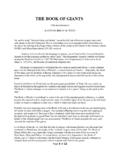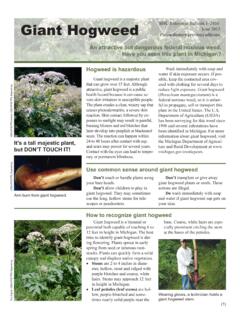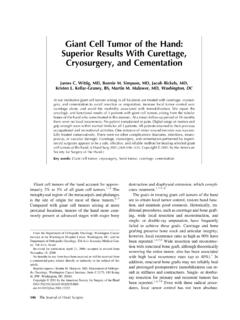Transcription of Giant cane (Arundinaria gigantea) Plant Guide
1 Plant GuideGIANT CANE arundinaria gigantea Muhl. Plant Symbol = ARGI Contributed by: USDA NRCS National Plants Data Team, Greensboro, NC Figure 1. Giant cane ( arundinaria gigantea ). Photo taken on tribal lands of the Mississippi Band of Choctaw Indians, taken by Tim Oakes, 2011. Alternate Names Cane, Fishing-pole Cane, Mutton Grass, Rivercane, Swampcane, Switchcane, Wild Bamboo Uses Cultural: Dense stands of cane, known as canebrakes, have been likened to a supermarket offering material for many purposes (Figure 2) (Kniffen et al. 1987). Cane provided the Cherokee with material for fuel and candles and the coarse, hollow stems were made into hair ornaments, game sticks, musical instruments, toys, weapons, and tools (Hill 1997; Hamel and Chiltoskey 1975).
2 The Houma, Koasati, Cherokee, Chitimacha, Chickasaw, Choctaw, and Seminole made the stems into arrow shafts, blowguns (Figure 3) and darts (Figure 4) for hunting squirrels, rabbits, and various birds (Bushnell 1909; Hamel and Chiltoskey 1975; Speck 1941; Kniffen et al. 1987). Young Cherokee boys used Giant cane blowguns armed with darts to protect ripening cornfields from scavenging birds and small mammals (Fogelson 2004). The Choctaw used the butt end of a cane, where the outside skin was thick, as a knife to cut meat, or as a weapon (Swanton 1931). Tribes of Louisiana made flutes, duck calls, and whistles out of cane (Kniffen et al.)
3 1987). Cane is best harvested in the fall or winter (October to February) for blow guns and flutes, and Plant stems, known as culms, are selected from mature, hardened off plants with larger diameters. Figure 2. Stand of Giant cane ( arundinaria gigantea ). Photo taken on tribal lands of the Mississippi Band of Choctaw Indians, taken by Timothy Oakes, 2011. Figure 3. A Choctaw man demonstrating how a blowgun is positioned for shooting. The blowgun is about 7 feet in length and made of a single piece of Giant cane. Photo by David I. Bushnell, Jr., 1909. Courtesy of the Smithsonian National Museum of Natural History, National Anthropological Archives.
4 Figure 4. Chitimacha blowgun darts of fire-treated split cane. Courtesy of the Department of Anthropology, Smithsonian Institution E76807. Young shoots were cooked as a potherb and ripe seeds were gathered in the summer or fall and ground into flour for food (Morton 1963; Hitchcock and Chase 1951). Flint (1828) says of a subspecies of Giant cane, arundinaria gigantea ssp. macrosperma: It produces an abundant crop of seed with heads like those of broom corn. The seeds are farinaceous and are said to be not much inferior to wheat, for which the Indians and occasionally the first settlers substituted it.
5 Giant cane also has medicinal properties. Both the Houma and the Seminole made a decoction of the roots: the Houma used it to stimulate the kidneys and renew strength, and the Seminole used it as a cathartic (Speck 1941; Sturtevant 1955 cited in Moerman 1998). Cane was important for construction of indigenous dwellings, as well as the creation of the mats and baskets that formed a large part of household furnishings (Galloway and Kidwell 2004). Entire canes were used for Choctaw beds, house roofs, and walls and they made pallets of whole canes on which to spread hides (Swanton 1931).
6 The Cherokee constructed dwellings with cane webbing, plastered with mud (Hamel and Chiltoskey 1975). The Pascagoula and the Biloxi made temples of cane as a resting place for their chiefs and the Choctaw placed their dead in Giant cane hampers (Brain et al. 2004; Swanton 1931). Woven mats of cane covered ceremonial grounds, seats, floors, and walls, and roofs were thatched with it (Hill 1997; Swanton 1946). The Natchez made cane mats with red and black designs, that were 4 ft. wide and 6 ft. long (Swanton 1946). The houses of Seminole chiefs were covered with checkered mats of canes dyed different colors (Bartram 1996).
7 The Houma, Biloxi, Chitimacha, Tunica, and Koasati used cane for the making of rafts, bedding, roofing, and floor and wall coverings (Kniffen et al. 1987). Archeological excavations have revealed that Giant cane was laid down in criss-crossed layers to mantle the sloping sides of the bases of certain mounds such as the Great Mound in east central Louisiana (Neuman 2006). One of the most important uses of Giant cane stems today and in ancient times is for forming the rich natural yellow color in the baskets of the Alabama Coushatta, Biloxi-Tunica, Caddo, Cherokee, Chitimacha, Choctaw, Creek, Koasati, Seminole and other tribes (Figures 5 and 6) (Brain et al.)
8 2004; Bushnell 1909; Gettys 1979; Gregory Jr. 2004; Hamel and Chiltoskey 1975; Swanton 1942). Figure 5. Haylaema, Choctaw, with a carrying basket made of Giant cane. Photograph by David I. Bushnell, Jr., St. Tammany Parish, La., 1909. Courtesy of the Smithsonian National Museum of Natural History, National Anthropological Archives, Pack, berry, sifting, chafing, winnowing, catch, storage, gift, and cooking baskets all carry stems of this grass (Duggan and Riggs 1991; Gettys 1979; 2003). Venison, buffalo meat, pumpkins, hominy and boiled beans were presented in serving vessels made of Giant cane.
9 Choctaw mothers lay their children in cradles of cane (Swanton 1946). Cherokee fish traps were made of Giant cane (Leftwich 1970). As non-Indians began to settle in the Southeastern United States, weavers from various tribes began to trade their baskets with the new settlers for items that they needed such as flour, coffee, sugar, ribbons, and fabric. Thus, cane basketry became part of the exchange-based colonial economy (Duggan and Riggs 1991; Lee 2002; 2006). Matting and basketry technologies that use Giant cane have been found in archaeological sites in Louisiana dating back to at least 2300 (Neuman 2006).
10 Figure 6. Zula Chitto, Mississippi Band of Choctaw Indians, weaving a basket of Giant cane. Photo by Bradley Isaac, Jr., Mississippi Band of Choctaw Indians. Giant cane was broken or cut to its base with a shell or bone knife or other lithic devices, and in later times other tools such as a sugar cane knife were used. Today pruning shears are frequently employed (Neuman 2006; Hill 1997; 2002). The Jena Band of Choctaw look for culms at least four feet long, of a solid color, and at least five to seven years old (Lee 2002). The Eastern Band of Cherokee select large canes about the size of the thumb that are at least two years old (Leftwich 1970).



















